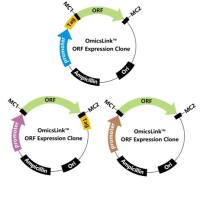MultiPipMaker: A Comparative Alignment Server for Multiple DNA Sequences
互联网
- Abstract
- Table of Contents
- Figures
- Literature Cited
Abstract
The MultiPipMaker World Wide Web server (http://www.bx.psu.edu) provides a tool for aligning multiple DNA sequences and visualizing regions of conservation among them. This unit describes its use and gives an explanation of the resulting output files and supporting tools. Features provided by the server include alignment of up to 20 very long genomic sequences, output choices of a true, nucleotide?level multiple alignment and/or stacked, pairwise percent identity plots, and support for user?specified annotations of genomic features and arbitrary regions, with clickable links to additional information. Input sequences other than the reference can be fragmented, unordered, and unoriented. Curr. Protoc. Bioinform. 30:10.4.1?10.4.14. © 2010 by John Wiley & Sons, Inc.
Keywords: multiple alignment; percent identity plot; genomic analysis; conserved non?coding sequences
Table of Contents
- Introduction
- Strategic Planning
- Basic Protocol 1: MultiPipMaker: Multiple Alignment Server
- Support Protocol 1: Installing and Using Stand‐Alone refine and single_cov Programs
- Support Protocol 2: Using PipHelper to Prepare MultiPipMaker Input Files from Data in the UCSC Genome Browser
- Guidelines for Understanding Results
- Commentary
- Literature Cited
- Figures
Materials
Figures
-
Figure 10.4.1 Flow chart outlining the steps for using MultiPipMaker. View Image -
Figure 10.4.2 Textual summary of a MultiPipMaker submission. This is returned as an acknowledgement page indicating that the job has been accepted, and is also included with the output. It lists the length of each sequence and displays a portion of the FASTA header line. It also gives information such as the options selected and the order of the sequences in the alignment. View Image -
Figure 10.4.3 Excerpt from the alignment of the paralogous HOX clusters in human. The HOXA4 locus is shown aligned to HOXB4 , HOXC4 , and HOXD4 . Each panel in the MultiPip represents a pairwise alignment to the HOXA reference sequence. The horizontal axis above the plots shows icons representing simple repeats (vertical bars), CpG islands (low rectangles), exons (numbered black boxes), the gene name, and the direction of transcription. The horizontal red and green bars at the very top are clickable annotation links (see text). Colored underlays within the plots represent annotations from the HOXA cluster; those in the top half of each panel include characterized promoter regions (pink), UTRs represented in the EST libraries (green), coding exons (red), introns (yellow), and annotated UTRs (light orange). Vertical bars in each bottom half represent experimentally characterized protein binding sites for AP2 (purple) and the RARE sequence (orange). The lower panel is an excerpt from a nucleotide‐level alignment in the region of the partly‐conserved RARE and non‐conserved AP2 transcription factor binding sites. Conserved nucleotides are shown as dots. View Image
Videos
Literature Cited
| Bejerano, G., Pheasant, M., Makunin, I., Stephen, S., Kent, W.J., Mattick, J.S., and Haussler, D. 2004. Ultraconserved elements in the human genome. Science 304:1321‐1325. | |
| Boncinelli, E., Somma, R., Acampora, D., Pannese, M., D'Esposito, M., Faiella, A., and Simeone, A. 1988. Organization of human homeobox genes. Hum. Reprod. 3:880‐886. | |
| Doerksen, L.F., Bhattacharya, A., Kannan, P., Pratt, D., and Tainsky, M.A. 1996. Functional interaction between a RARE and an AP‐2 binding site in the regulation of the human HOX A4 gene promoter. Nucleic Acids Res. 24:2849‐2856. | |
| Elnitski, L., Riemer, C., Petrykowska, H., Florea, L., Schwartz, S., Miller, W., and Hardison, R. 2002. PipTools: A computational toolkit to annotate and analyze pairwise comparisons of genomic sequences. Genomics. 80:681‐690. | |
| Elnitski, L., Hardison, R.C., Li, J., Yang, S., Kolbe, D., Eswara, P., O'Connor, M.J., Schwartz, S., Miller, W., and Chiaromonte, F. 2003. Distinguishing regulatory DNA from neutral sites. Genome Res. 13:64‐72. | |
| Gardiner‐Garden, M. and Frommer, M. 1987. CpG islands in vertebrate genomes. J. Mol. Biol. 196:261‐282. | |
| Kolbe, D., Taylor, J., Elnitski, L., Eswara, P., Li, J., Miller, W., Hardison, R., and Chiaromonte, F. 2004. Regulatory potential scores from genome‐wide three‐way alignments of human, mouse, and rat. Genome Res. 14:700‐707. | |
| Margulies, E.H., Blanchette, M., Haussler, D., Green, E.D., and NISC Comparative Sequencing Program. 2003. Identification and characterization of multi‐species conserved sequences. Genome Res. 13:2507‐2518. | |
| Morrison, A., Moroni, M.C., Ariza‐McNaughton, L., Krumlauf, R., and Mavilio, F. 1996. In vitro and transgenic analysis of a human HOXD4 retinoid‐responsive enhancer. Development 122:1895‐1907. | |
| Pough, F.H., Janis, C.M., and Heiser, J.B. 1999. Vertebrate Life. Prentice Hall, Englewood Cliffs, N.J. | |
| Santini, S., Boore, J.L., and Meyer, A. 2003. Evolutionary conservation of regulatory elements in vertebrate Hox gene clusters. Genome Res. 13:1111‐1122. | |
| Schwartz, S., Zhang, Z., Frazer, K.A., Smit, A., Riemer, C., Bouck, J., Gibbs, R., Hardison, R.C., and Miller, W. 2000. PipMaker—a Web server for aligning two genomic DNA sequences. Genome Res. 10:577‐586. | |
| Schwartz, S., Elnitski, L., Li, M., Weirauch, M., Riemer, C., Smit, A., Green, E.D., Hardison, R.C., Miller, W., and NISC Comparative Sequencing Program. 2003a. MultiPipMaker and supporting tools: Alignments and analysis of multiple genomic DNA sequences. Nucleic Acids Res. 31:3518‐3524. | |
| Schwartz, S., Kent, W.J., Smit, A., Zhang, Z., Baertsch, R., Hardison, R.C., Haussler, D, and Miller, W. 2003b. Human mouse alignments with BLASTZ. Genome Res. 13:103‐107. | |
| Siepel, A. and Haussler, D. 2003. Combining phylogenetic and hidden Markov models in biosequence analysis. In Proceedings of the Seventh Annual International Conference on Computational Molecular Biology (RECOMB 2003) pp. 277‐286. International Society for Computational Biology, La Jolla, Calif. | |
| Stojanovic, N., Florea, L., Riemer, C., Gumucio, D., Slightom, J., Goodman, M., Miller, W., and Hardison, R. 1999. Comparison of five methods for finding conserved sequences in multiple alignments of gene regulatory regions. Nucleic Acids Res. 27:3899‐3910. | |
| Thomas, J.W., Touchman, J.W., Blakesley, R.W., Bouffard, G.G., Beckstrom‐Sternberg, S.M., Margulies, E.H., Blanchette, M., Siepel, A.C., Thomas, P.J., McDowell, J.C., Maskeri, B., Hansen, N.F., Schwartz, M.S., Weber, R.J., Kent, W.J., Karolchik, D., Bruen, T.C., Bevan, R., Cutler, D.J., Schwartz, S., Elnitski, L., Idol, J.R., Prasad, A.B., Lee‐Lin, S.Q., Maduro, V.V., Summers, T.J., Portnoy, M.E., Dietrich, N.L., Akhter, N., Ayele, K., Benjamin, B., Cariaga, K., Brinkley, C.P., Brooks, S.Y., Granite, S., Guan, X., Gupta, J., Haghighi, P., Ho, S.L., Huang, M.C., Karlins, E., Laric, P.L., Legaspi, R., Lim, M.J., Maduro, Q.L., Masiello, C.A., Mastrian, S.D., McCloskey, J.C., Pearson, R., Stantripop, S., Tiongson, E.E., Tran, J.T., Tsurgeon, C., Vogt, J.L., Walker, M.A., Wetherby, K.D., Wiggins, L.S., Young, A.C., Zhang, L.H., Osoegawa, K., Zhu, B., Zhao, B., Shu, C.L., De Jong, P.J., Lawrence, C.E., Smit, A.F., Chakravarti, A., Haussler, D., Green, P., Miller, W., and Green, E.D. 2003. Comparative analyses of multi‐species sequences from targeted genomic regions. Nature 424:788‐793. | |
| Tufarelli, C., Hardison, R., Miller, W., Hughes, J., Clark, K., Ventress, N., Frischauf, A.M., and Higgs, D.R. 2004. Comparative analysis of the alpha‐like globin clusters in mouse, rat, and human chromosomes indicates a mechanism underlying breaks in conserved synteny. Genome Res. 14:623‐630. | |
| Waterston, R.H., Lindblad‐Toh, K., Birney, E., Rogers, J., Abril, J.F., Agarwal, P., Agarwala, R., Ainscough, R., Alexandersson, M., An, P., Antonarakis, S.E., Attwood, J., Baertsch, R., Bailey, J., Barlow, K., Beck, S., Berry, E., Birren, B., Bloom, T., Bork, P., Botcherby, M., Bray, N., Brent, M.R., Brown, D.G., Brown, S.D., Bult, C., Burton, J., Butler, J., Campbell, R.D., Carninci, P., Cawley, S., Chiaromonte, F., Chinwalla, A.T., Church, D.M., Clamp, M., Clee, C., Collins, F.S., Cook, L.L., Copley, R.R., Coulson, A., Couronne, O., Cuff, J., Curwen, V., Cutts, T., Daly, M., David, R., Davies, J., Delehaunty, K.D., Deri, J., Dermitzakis, E.T., Dewey, C., Dickens, N.J., Diekhans, M., Dodge, S., Dubchak, I., Dunn, D.M., Eddy, S.R., Elnitski, L., Emes, R.D., Eswara, P., Eyras, E., Felsenfeld, A., Fewell, G.A., Flicek, P., Foley, K., Frankel, W.N., Fulton, L.A., Fulton, R.S., Furey, T.S., Gage, D., Gibbs, R.A., Glusman, G., Gnerre, S., Goldman, N., Goodstadt, L., Grafham, D., Graves, T.A., Green, E.D., Gregory, S., Guigo, R., Guyer, M., Hardison, R.C., Haussler, D., Hayashizaki, Y., Hillier, L.W., Hinrichs, A., Hlavina, W., Holzer, T., Hsu, F., Hua, A., Hubbard, T., Hunt, A., Jackson, I., Jaffe, D.B., Johnson, L.S., Jones, M., Jones, T.A., Joy, A., Kamal, M., Karlsson, E.K., Karolchik, D., Kasprzyk, A., Kawai, J., Keibler, E., Kells, C., Kent, W.J., Kirby, A., Kolbe, D.L., Korf, I., Kucherlapati, R.S., Kulbokas, E.J., Kulp, D., Landers, T., Leger, J.P., Leonard, S., Letunic, I., Levine, R., Li, J., Li, M., Lloyd, C., Lucas, S., Ma, B., Maglott, D.R., Mardis, E.R., Matthews, L., Mauceli, E., Mayer, J.H., McCarthy, M., McCombie, W.R., McLaren, S., McLay, K., McPherson, J.D., Meldrim, J., Meredith, B., Mesirov, J.P., Miller, W., Miner, T.L., Mongin, E., Montgomery, K.T., Morgan, M., Mott, R., Mullikin, J.C., Muzny, D.M., Nash, W.E., Nelson, J.O., Nhan, M.N., Nicol, R., Ning, Z., Nusbaum, C., O'Connor, M.J., Okazaki, Y., Oliver, K., Overton‐Larty, E., Pachter, L., Parra, G., Pepin, K.H., Peterson, J., Pevzner, P., Plumb, R., Pohl, C.S., Poliakov, A., Ponce, T.C., Ponting, C.P., Potter, S., Quail, M., Reymond, A., Roe, B.A., Roskin, K.M., Rubin, E.M., Rust, A.G., Santos, R., Sapojnikov, V., Schultz, B., Schultz, J., Schwartz, M.S., Schwartz, S., Scott, C., Seaman, S., Searle, S., Sharpe, T., Sheridan, A., Shownkeen, R., Sims, S., Singer, J.B., Slater, G., Smit, A., Smith, D.R., Spencer, B., Stabenau, A., Stange‐Thomann, N., Sugnet, C., Suyama, M., Tesler, G., Thompson, J., Torrents, D., Trevaskis, E., Tromp, J., Ucla, C., Ureta‐Vidal, A., Vinson, J.P., Von Niederhausern, A.C., Wade, C.M., Wall, M., Weber, R.J., Weiss, R.B., Wendl, M.C., West, A.P., Wetterstrand, K., Wheeler, R., Whelan, S., Wierzbowski, J., Willey, D., Williams, S., Wilson, R.K., Winter, E., Worley, K.C., Wyman, D., Yang, S., Yang, S.P., Zdobnov, E.M., Zody, M.C., Lander, E.S., and the Mouse Genome Sequencing Consortium. 2002. Initial sequencing and comparative analysis of the mouse genome. Nature 420:520‐562. | |
| Key References | |
| Schwartz et al., 2000. See above. | |
| Describes the PipMaker server. PipMaker computes and displays pairwise alignments whereas MultiPipMaker computes and displays multiple sequence alignments. | |
| Schwartz et al., 2003a. See above. | |
| Describes the MultiPipMaker server and supporting tools. | |
| Internet Resources | |
| http://www.bx.psu.edu | |
| Links to alignment programs including PipMaker and MultiPipMaker, software, publications, example pages, and instructions for use of the tools and the server. | |
| http://genome.ucsc.edu | |
| Home page for the UCSC Genome Browser. | |
| http://www.adobe.com | |
| Home page for downloading Adobe Reader. | |
| http://www.gzip.org | |
| Home page for the GNUzip software package. | |
| http://www.ncbi.nlm.nih.gov/sites/entrez?db=nucleotide | |
| Entrez Nucleotide Web site containing sequenced DNA from numerous sources. | |
| http://www.ncbi.nlm.nih.gov/sites/entrez?db=gene | |
| Entrez Gene Web site containing annotations of genes and links to related resources. | |
| http://www.ncbi.nlm.nih.gov/pubmed/ | |
| PubMed Web site: repository of published scientific literature. | |
| http://www.genome.gov/1005107 | |
| ENCODE Project homepage. Links to sequences and general information about the project. |







